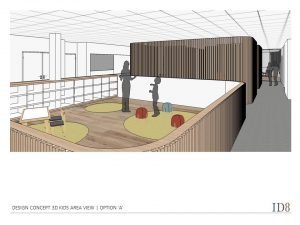In the midst of all of the excitement of this month…Domestic Violence Awareness Month, the Reach for the Stars Gala, new staff members starting…the new office continues to take shape!
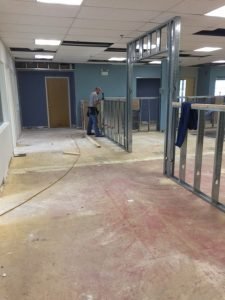
Hopefully you’ve been following along, but in case you missed them, take a moment to catch up with previous updates here, here, and here.
If you’ve ever been through a construction project of your own, then you know that it can seem like nothing is happening for the longest time, and then all of a sudden things move very quickly. That’s how it’s been for us. It feels like we’ve been dreaming about this move forever and suddenly, it’s becoming very real – very soon!
The REACH staff is getting almost daily updates from our colleagues supervising the project. When we last updated you, the construction crew had begun framing out the walls. Since then, they have added the sheetrock and plaster, and we now have real walls! Those walls are being painted, and next week we are looking forward to carpets being installed.
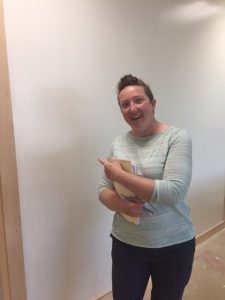
There’s one area of the new space that only has half-walls – not unfinished, but half. Why is that? Because that’s the area of the new office devoted to the play space for children. Children are a big part of the work we do here at REACH. When a survivor comes to us for help, we get to know as much about them as they feel comfortable sharing. Often we hear about how the abuse has affected their children, and how they have hopes and dreams – just like everyone does – for their children to be healthy and to succeed in life.
Research – and our experience – has shown that the best way to help kids who have witnessed or experienced violence in the home go on to lead healthy, productive lives is employing specialized therapeutic interventions. That sounds technical! What it means is that kids need to talk to someone who can understand where they are in their emotional development, speak at their level, and can lead them in activities that make sense to them – activities that will help them deal with what they’ve been through.
We approach this opportunity in a couple of ways. Our Child and Adolescent Therapist is bilingual (Spanish/English) and specializes in art therapy. Trauma affects the part of the brain that is primitive and pre-verbal. A child may react to the world around them in certain ways out of instinct – an instinct that might be overdeveloped as a result of trauma. Because of the area of the brain where these instincts are located, talk therapy alone may not be able to access and address the reactions that are taking place. Art therapy helps children process their experience in a way that doesn’t rely solely on words.
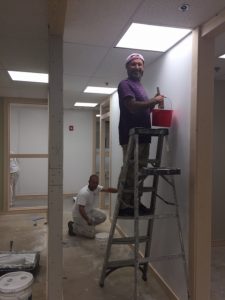
In addition, our therapy spaces are equipped with sensory tools that can help children recognize and cope with their body’s physical responses to trauma. We pay close attention to the bond between the child and the caregiver. Whereas other types of therapy typically look solely at the child’s behavior, this work focuses on both the child’s and the adult’s responses to trauma and allows the therapist to work with the caregiver, offering them techniques to practice directly with the child.
After therapy to address these issues and to learn healthy coping skills, we see improvements in school, stronger friendships, and increased self-esteem that positively affect their peers as well. Just recently, we shared with you about “Alex,” the young artist who designed a plate for this year’s Reach for the Stars Gala. Alex is just one of the many children who will benefit from the new space. By creating space for children to express themselves, we support the healthy development of the youngest survivors; kids who might otherwise continue to suffer the effects of the violence they have witnessed. Kids learn that it is okay to trust, to experience feelings, and to talk about those feelings. At REACH, we create a space that is safe, where all feelings are acceptable, and where we model appropriate behavior.
Some kids may not participate at REACH in therapy, but they still come to REACH fairly often, when their parent meets with an advocate or attends a support group. When children accompany a parent to the REACH office, they are cared for by volunteers who go through REACH’s extensive 40-hour volunteer training. In the training, the volunteers learn about impacts that trauma and exposure to violence have on children, responses to trauma and how that influences behaviors they might notice (like acting out or violent behavior), support strategies, and how to model healthy boundaries.
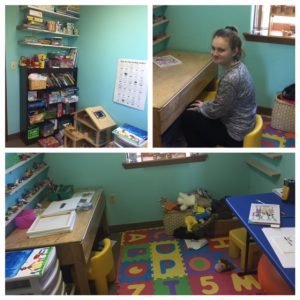
Right now, all of this amazing work happens at REACH’s office in less than ideal conditions. We have one small room for child therapy, and no space for storage. All of the toys and games are in one spot, and right within view of the child who’s having a session with the therapist. It can be hard for a child to stay focused on what they’re doing or talking about with so much temptation in sight. In addition, there’s no separate space for teens, and so when teenage clients meet with the therapist, they have to sit in a space that can feel juvenile and, quite literally, beneath them (the chairs are tiny!). What’s more, the space where volunteers care for children during meetings is a makeshift sitting area full of toys that functions as a play space.
The new office will have multiple spaces for children: a larger, more fully-equipped space for child therapy, a separate space for therapy with teens, and a large, dedicated, central space for play. It’s big enough to store plenty of toys, and has that wonderful half-wall to keep the kids and their toys somewhat contained. This feature also allows survivors who are meeting with an advocate in one of the surrounding offices to keep an easy quick view of their child as they play.

We are thrilled to be moving into this space in the coming weeks, and to finally have appropriate space that reflects how important children are to our work. With them, we will reach beyond domestic violence.
